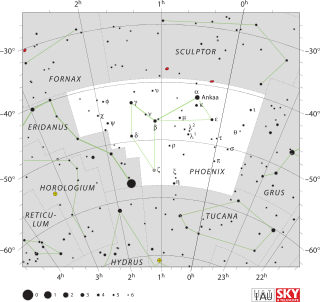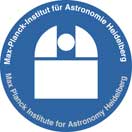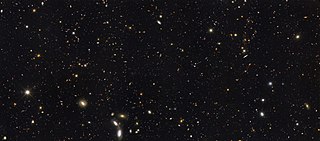
Phoenix is a minor constellation in the southern sky. Named after the mythical phoenix, it was first depicted on a celestial atlas by Johann Bayer in his 1603 Uranometria. The French explorer and astronomer Nicolas Louis de Lacaille charted the brighter stars and gave their Bayer designations in 1756. The constellation stretches from roughly −39° to −57° declination, and from 23.5h to 2.5h of right ascension. The constellations Phoenix, Grus, Pavo and Tucana, are known as the Southern Birds.

An irregular galaxy is a galaxy that does not have a distinct regular shape, unlike a spiral or an elliptical galaxy. Irregular galaxies do not fall into any of the regular classes of the Hubble sequence, and they are often chaotic in appearance, with neither a nuclear bulge nor any trace of spiral arm structure.

The Boomerang Nebula is a protoplanetary nebula located 5,000 light-years away from Earth in the constellation Centaurus. It is also known as the Bow Tie Nebula and catalogued as LEDA 3074547. The nebula's temperature is measured at 1 K making it the coolest natural place currently known in the Universe.

NGC 3982, also known as UGC 6918, is an intermediate spiral galaxy approximately 68 million light-years away in the constellation Ursa Major. It was discovered by William Herschel on April 14, 1789, and misclassified as a planetary nebula. NGC 3982 is a part of the M109 Group.

The Catalogue of Principal Galaxies (PGC) is an astronomical catalog published in 1989 that lists B1950 and J2000 equatorial coordinates and cross-identifications for 73,197 galaxies. It is based on the Lyon-Meudon Extragalactic Database (LEDA), which was originally started in 1983. 40,932 coordinates (56%) have standard deviations smaller than 10″. A total of 131,601 names from the 38 most common sources are listed. Available mean data for each object are given:

NGC 4881 is an elliptical galaxy in the northern constellation of Coma Berenices. It was discovered by the German astronomer Heinrich Louis d'Arrest on April 22, 1865. John L. E. Dreyer described it as "faint, small, a little extended, 9th magnitude star to southwest". This object is located at a distance of approximately 309 megalight-years from the Milky Way. It is a member of the Coma cluster of galaxies, positioned around 18′ to the north of the cluster's center with no nearby galactic neighbors.

NGC 1569 is a dwarf irregular galaxy in Camelopardalis. The galaxy is relatively nearby and consequently, the Hubble Space Telescope can easily resolve the stars within the galaxy. The distance to the galaxy was previously believed to be only 2.4 Mpc. However, in 2008 scientists studying images from Hubble calculated the galaxy's distance at nearly 11 million light-years away, about 4 million light-years farther than previously thought, meaning it is a member of the IC 342 group of galaxies.

The Max-Planck-Institut für Astronomie is a research institute of the Max Planck Society (MPG). It is located in Heidelberg, Baden-Württemberg, Germany near the top of the Königstuhl, adjacent to the historic Landessternwarte Heidelberg-Königstuhl astronomical observatory. The institute primarily conducts basic research in the natural sciences in the field of astronomy.

NGC 4639 is a barred spiral galaxy located in the equatorial constellation of Virgo. It was discovered by German-born astronomer William Herschel on April 12, 1784. John L. E. Dreyer described it as "pretty bright, small, extended, mottled but not resolved, 12th magnitude star 1 arcmin to southeast". This is a relatively nearby galaxy, lying approximately 72 million light-years away from the Milky Way. It is a companion to NGC 4654, and the two appear to have interacted roughly 500 million years ago. NGC 4639 is a member of the Virgo Cluster.

NGC 4605 is a dwarf barred spiral galaxy in the constellation Ursa Major, located at a distance of 18.1 ± 0.3 megalight-years from the Milky Way. Physically it is similar in size and in B-band absolute magnitude to the Large Magellanic Cloud. It is a member of the M81 Galaxy Group, along with Messier 81 and Messier 101.

NGC 3632 and NGC 3626 is an unbarred lenticular galaxy and Caldwell object in the constellation Leo. It was discovered by William Herschel, on 14 March 1784. It shines at magnitude +10.6/+10.9. Its celestial coordinates are RA 11h 20.1m, dec +18° 21′. It is located near the naked-eye-class A4 star Zosma, as well as galaxies NGC 3608, NGC 3607, NGC 3659, NGC 3686, NGC 3684, NGC 3691, NGC 3681, and NGC 3655. Its dimensions are 2′.7 × 1′.9. The galaxy belongs to the NGC 3607 group some 70 million light-years distant, itself one of the many Leo II groups.

The Great Observatories Origins Deep Survey, or GOODS, is an astronomical survey combining deep observations from three of NASA's Great Observatories: the Hubble Space Telescope, the Spitzer Space Telescope, and the Chandra X-ray Observatory, along with data from other space-based telescopes, such as XMM Newton, and some of the world's most powerful ground-based telescopes.

NGC 4666 is a spiral galaxy in the equatorial constellation of Virgo, located at a distance of approximately 55 megalight-years from the Milky Way. It was discovered by the German-born astronomer William Herschel on February 22, 1784. It is a member of the Virgo II Groups, a series of galaxies and galaxy clusters strung out from the southern edge of the Virgo Supercluster. John L. E. Dreyer described it as "bright, very large, much extended 45°±, pretty suddenly brighter middle". It is a member of an interacting system with NGC 4668 and a dwarf galaxy, and belongs to a small group that also includes NGC 4632.

NGC 1560, also known as IC 2062, is an 11th-magnitude spiral galaxy, in the IC 342/Maffei Group. It was discovered by Wilhelm Tempel on August 1, 1883.

NGC 4138 is the New General Catalogue identifier for a lenticular galaxy in the northern constellation of Canes Venatici. Located around 52 million light years from Earth, it spans some 2.1 × 1.3 arc minutes and has an apparent visual magnitude of 11.3. The morphological classification of NGC 4138 is SA0+(r), indicating it lacks a bar formation and has tightly wound spiral arms with a ring-like structure around the nucleus. It has no nearby companion galaxies.

IC 2006 is an elliptical galaxy in the constellation Eridanus. The galaxy was discovered on 3 October 1897 by the American astronomer Lewis A. Swift. It is estimated to be around 60 to 70 million light years away, in the Fornax Cluster. The galaxy is one of the smaller in the Fornax cluster, with a diameter of only 35 000 light-years.

NGC 546 is a barred spiral galaxy about 270 million light years away from Earth and located in the constellation Sculptor. The largest diameter is 1.40 and the smallest is 0.5 angular minutes. The first discovery was made by John Frederick William Herschel on 23 October 1835.

NGC 3156 is a lenticular galaxy located in the constellation Sextans. It is located at a distance of about 75 million light-years from Earth and is forming a pair with NGC 3169. It was discovered by astronomer William Herschel on December 13, 1784.

PGC or LEDA 2933 is a faint dwarf irregular galaxy in the Sculptor Group. It can be seen in the southern constellation Phoenix. According to measurements, the galaxy is located 11.15 million light-years away.

ESO 383-76 is an elongated, X-ray luminous supergiant elliptical galaxy, residing as the dominant, brightest cluster galaxy (BCG) of the Abell 3571 galaxy cluster, the sixth-brightest in the sky at X-ray wavelengths. It is located at the distance of 200.6 megaparsecs from Earth, and is possibly a member of the large Shapley Supercluster. With a diameter of about 540.89 kiloparsecs, it is one of the largest galaxies known.




















